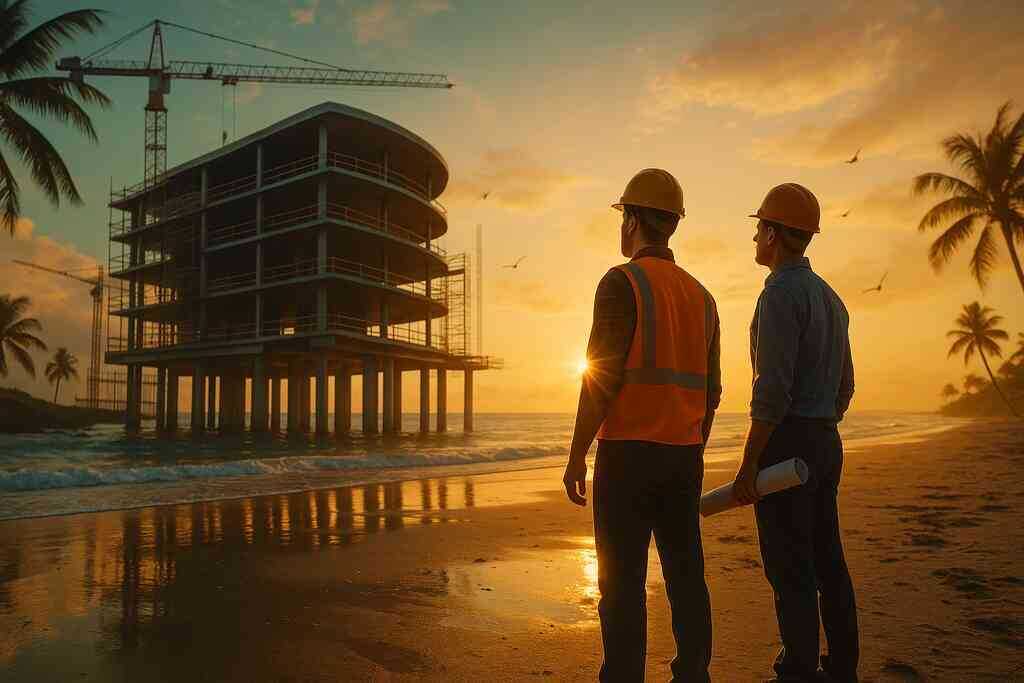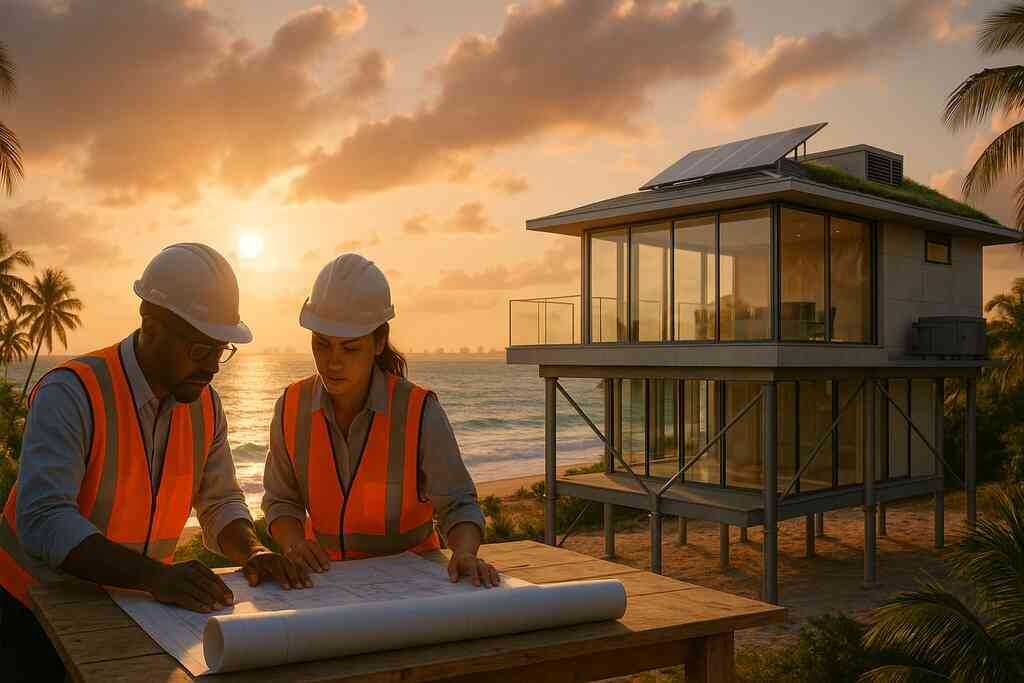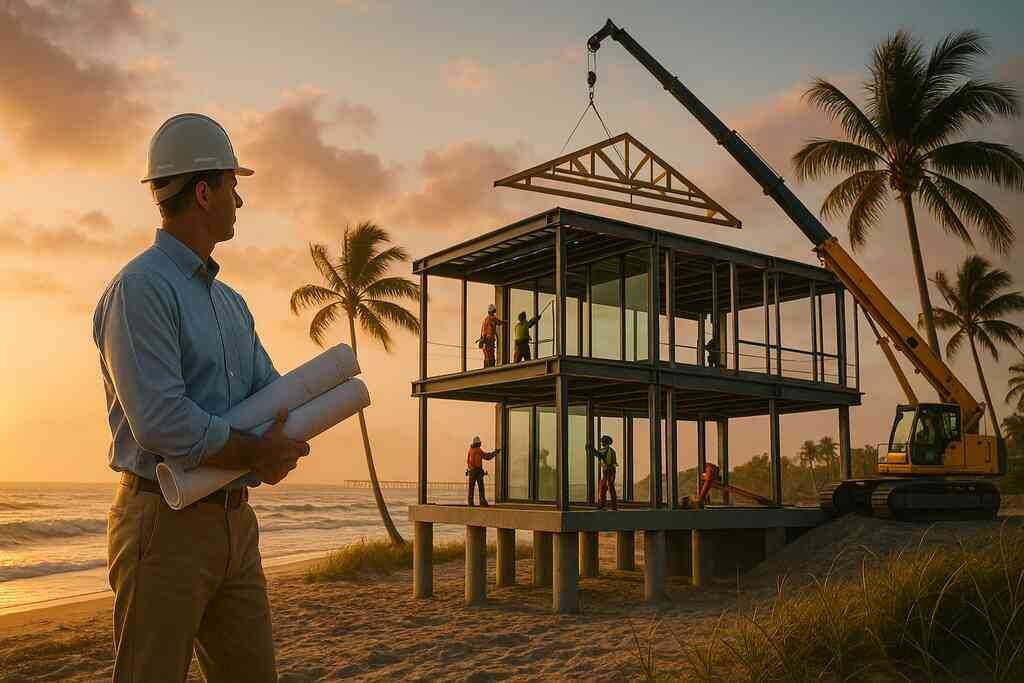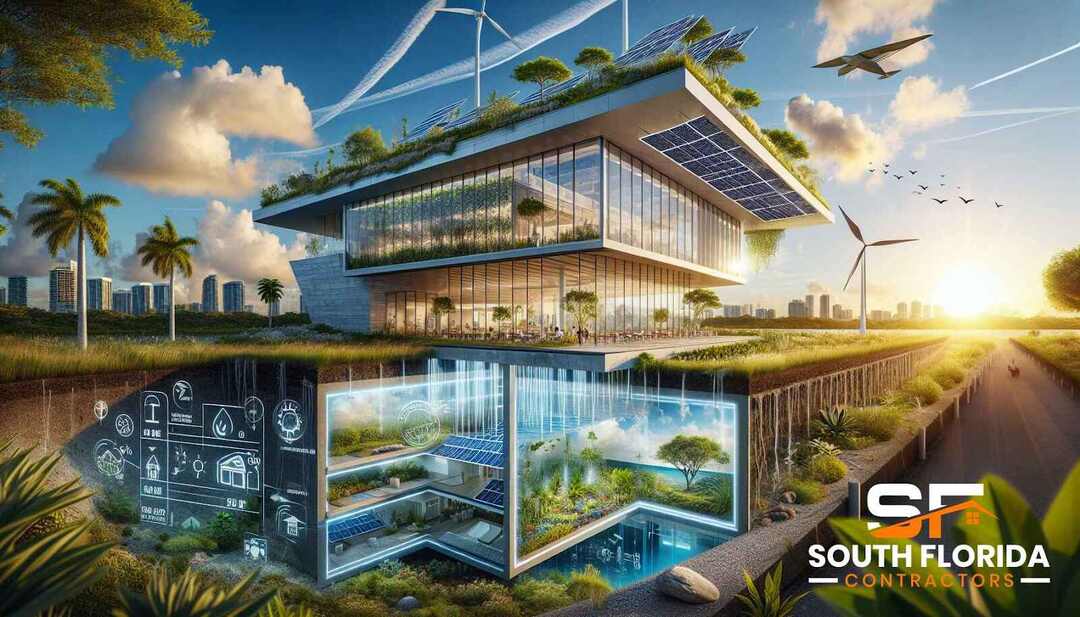
Top 5 Energy-Efficient Construction Practices
March 15, 2024
Introduction to Energy-Efficient Construction
The importance of building green in South Florida
In the vibrant and diverse region of South Florida, the push towards energy-efficient building is more than just a trend, it’s a necessity. The environmental conditions – marked by hot summers and frequent storms – necessitate innovative construction practices that not only protect the environment but also contribute to long-term savings for homeowners and businesses alike. Green construction practices in South Florida are not just about adhering to trends but are essential strategies for creating resilient, sustainable communities. Utilizing sustainable materials and energy-saving technologies helps mitigate the impact of urban development on the delicate ecosystems found throughout the South Florida region, while also providing a blueprint for responsible growth amid rapid urbanization.
Understanding the benefits of energy efficiency
Energy efficiency in construction is about much more than reducing utility bills. It encompasses a holistic approach to building, where every component and phase of construction is designed with the goal of minimizing environmental impact. Benefits of energy-efficient construction include reduced greenhouse gas emissions, lower operational costs, improved indoor air quality, and enhanced comfort for occupants. By focusing on sustainable construction, South Florida’s green building initiatives play a crucial role in combating the broader issues of climate change and environmental degradation. The adoption of high-efficiency HVAC systems and energy-efficient windows represents just a slice of the myriad ways builders can achieve greater sustainability and efficiency in their projects.
How South Florida Contractors prioritize sustainability
Sustainability is at the forefront of the South Florida construction industry, with contractors embracing a variety of strategies to ensure projects are both efficient and environmentally friendly. This includes everything from incorporating solar energy into new builds to employing innovative materials that reduce thermal gain. In addition, many South Florida general contractors are actively seeking LEED certification for their projects, demonstrating a commitment to green building practices that go above and beyond standard requirements. By prioritizing sustainability, construction companies in the area are not only contributing to a healthier planet but are also delivering modern, efficient buildings that stand as a testament to the region’s commitment to green development. Through a combination of cutting-edge technology, innovative design, and an unwavering commitment to the environment, South Florida contractors are leading the way in transforming the landscape of energy-efficient construction.
Innovative Green Construction Materials
As South Florida contractors continue to lead in the realm of energy-efficient building, the adoption of innovative green construction materials has become a hallmark of modern projects. This section delves into the materials that are setting new standards for sustainability and efficiency in construction.
Eco-friendly Insulation Solutions
One of the cornerstones of energy-efficient construction is the use of eco-friendly insulation materials. Traditional insulation options, while effective in their primary function, often carry a significant environmental footprint. South Florida general contractors are now turning to materials like recycled denim, sheep’s wool, and rigid polystyrene foam, which offer excellent thermal resistance without the harmful side effects associated with their predecessors. These materials not only reduce energy consumption by keeping buildings cooler in summer and warmer in winter but also contribute to healthier indoor air quality by minimizing the release of toxic substances.
Eco-friendly insulation also extends to innovations like green roofs and wall systems that incorporate living plants, offering not just insulation but also air purification benefits. The integration of such solutions reflects a broader commitment to sustainable construction practices that benefit both the environment and the building occupants.
Sustainable Landscaping Materials
Landscaping, often overlooked in discussions about building efficiency, plays a crucial role in the energy performance of South Florida properties. Sustainable landscaping materials, including native plants, permeable paving, and mulch from recycled sources, are pivotal in creating outdoor spaces that require minimal irrigation and maintenance. By selecting plants adapted to South Florida’s climate, contractors can significantly reduce water usage and the heat island effect, a phenomenon where built-up areas are significantly warmer than their rural surroundings, thereby lowering the demand for cooling systems inside buildings.
Furthermore, the use of recycled glass and rubber for paths and playground surfaces demonstrates how construction companies are creatively repurposing materials to enhance the sustainability of their projects. Such practices not only conserve natural resources but also contribute to the aesthetic and functional value of the outdoor space.
Reflective Roofing Materials for Heat Reduction
The choice of roofing materials plays a critical role in the thermal performance of buildings. In South Florida’s warm climate, reflective roofing materials have emerged as a key strategy for reducing energy consumption. These materials, including cool roof coatings, metal roofs, and tiles with high solar reflectance, can significantly lower roof surface temperatures, thereby reducing the heat transferred into buildings.
By reflecting more sunlight and absorbing less heat, reflective roofs can lower air conditioning needs, leading to substantial energy savings and improved comfort for occupants. This approach is especially beneficial in South Florida, where the demand for cooling is high throughout much of the year. The adoption of reflective roofing materials aligns with broader green construction practices, contributing to the overall goal of creating more sustainable and energy-efficient buildings.
High-Performance Energy Systems
Solar energy applications in South Florida construction
The embracing of solar energy in South Florida construction is a testament to the region’s commitment to sustainable construction. The abundant sunshine provides an ideal setting for harnessing solar power, making it an invaluable resource for energy-efficient buildings. South Florida contractors are integrating solar panels into both residential and commercial projects to significantly reduce reliance on traditional energy sources. This transition not only supports environmental sustainability but also offers long-term cost savings for property owners.
Installations range from rooftop panels to larger solar arrays for commercial properties, all designed to meet a building’s energy needs while reducing carbon footprints. Furthermore, solar energy applications extend beyond electricity generation. Solar water heating systems are increasingly becoming a preferred choice for hot water provision, demonstrating the versatile benefits of solar energy in construction.
Geothermal heating and cooling systems
Geothermal heating and cooling systems represent another frontier in the quest for energy efficiency in South Florida’s construction sector. Leveraging the stable temperatures underground, these systems provide an efficient way to heat and cool buildings, significantly lowering energy consumption compared to traditional HVAC systems. The process involves circulating water or a coolant through pipes buried underground, where the temperature remains constant, to exchange heat with the earth.
This method is particularly effective in South Florida’s climate, where the high cost of air conditioning can be a significant financial burden. Geothermal systems offer a sustainable alternative, reducing energy use by up to 50% in some cases. The upfront cost of installing geothermal systems can be higher, but the long-term savings and environmental benefits make it a worthwhile investment for those seeking to build green.
High-efficiency HVAC systems for optimal climate control
The selection and installation of high-efficiency HVAC systems are pivotal in achieving optimal climate control in South Florida’s energy-efficient buildings. These systems are designed to use less energy while providing superior heating, cooling, and ventilation performance. Advanced features like programmable thermostats and variable speed motors adjust operation based on real-time needs, further enhancing energy savings.
South Florida contractors are experienced in identifying and installing the most suitable high-efficiency HVAC units for each project, considering factors like building size, orientation, and occupancy patterns. By prioritizing these systems, construction projects not only adhere to Florida building codes for energy but also contribute to a more sustainable and comfortable living environment. Moreover, advancements in HVAC technology continue to push the envelope, with systems becoming smarter and more integrated with other building systems, promising even greater efficiency and user control in the future.
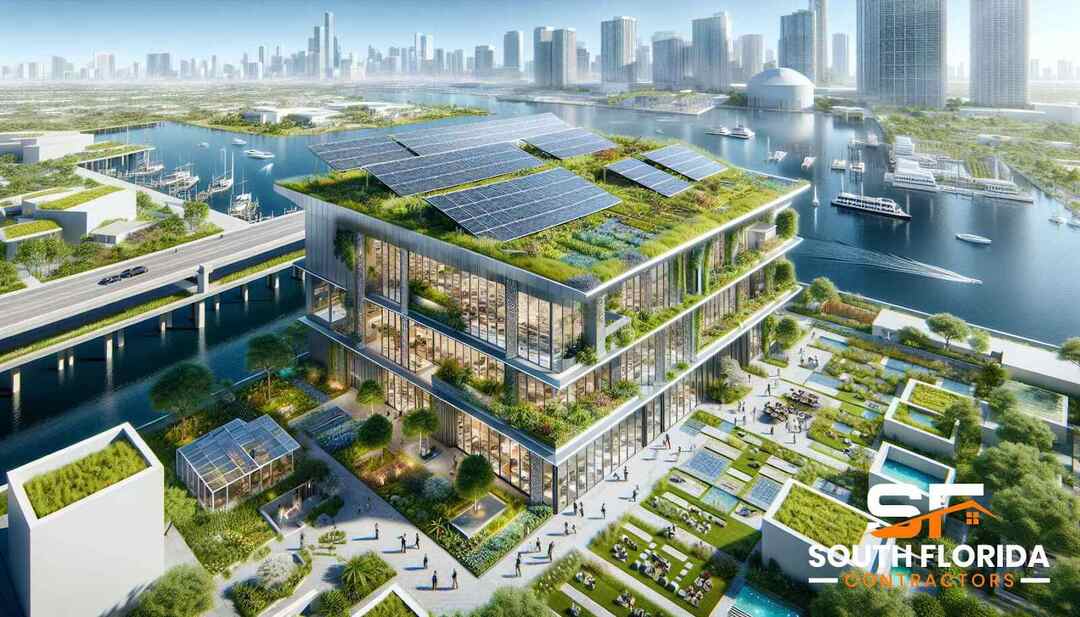
Smart Design and Building Techniques
In the realm of energy-efficient construction, smart design, and building techniques are pivotal in maximizing sustainability while minimizing environmental impact. South Florida Contractors is committed to implementing these progressive practices to ensure buildings are not only aesthetically pleasing but also highly functional and sustainable. By focusing on passive solar design, thermal mass, and rainwater harvesting systems, contractors can create structures that are in harmony with South Florida’s unique climate and environment.
Passive solar design for natural lighting and heating
Passive solar design is a cornerstone of energy-efficient construction, leveraging the sun’s energy for natural lighting and heating without mechanical means. This approach significantly reduces the reliance on artificial lighting and heating systems, thus decreasing energy consumption and costs. In South Florida, where sunshine is abundant, incorporating large, strategically placed windows can maximize natural light and warmth during cooler months while minimizing heat gain during the summer through the use of shading devices, reflective materials, and proper orientation. By paying meticulous attention to the building’s location and seasonal variations in sun path, South Florida contractors ensure that passive solar design not only enhances comfort and livability but also contributes to the overall energy efficiency of the structure.
Utilizing thermal mass for better energy storage
Employing materials with high thermal mass in construction is another innovative strategy utilized by contractors to enhance energy efficiency. Materials such as concrete, brick, and stone have the ability to absorb and store heat from the sun during the day and release it slowly as temperatures drop, maintaining a more consistent indoor temperature. In South Florida’s climate, this can translate to significant reductions in the need for heating and cooling, leading to lower energy bills and a more comfortable living environment. The strategic placement of materials with high thermal mass within a building’s interior can serve as a passive heating and cooling system, regulating the structure’s temperature naturally and effectively.
Rainwater harvesting systems for sustainable water use
Incorporating rainwater harvesting systems into building designs is a key aspect of sustainable construction practices. These systems collect and store rainwater from rooftops, which can then be used for irrigation, toilet flushing, and other non-potable uses. Given South Florida’s occasional heavy rainfall, capturing this resource significantly reduces the demand for municipal water supplies and diminishes stormwater runoff, which can lead to erosion and water pollution. South Florida contractors are adept at designing and installing these systems, ensuring they are seamlessly integrated into both new and existing structures. By utilizing rainwater harvesting, buildings become more self-sufficient, contributing to water conservation and sustainability goals in the region.
By embracing these smart design and building techniques, South Florida Contractors not only advocate for energy-efficient practices but also pave the way for a more sustainable construction industry. Each approach, from passive solar design and thermal mass utilization to rainwater harvesting, exemplifies a commitment to innovation, efficiency, and environmental stewardship, showcasing South Florida’s leadership in green building practices.
Advanced Technology for Energy Management
Energy-efficient construction in South Florida is not just about the materials used or the design of a building, it’s also increasingly about leveraging advanced technology to manage and reduce energy consumption effectively. As part of the efforts to promote green construction practices, contractors are incorporating sophisticated systems and technology solutions that contribute significantly to energy management. This section delves into the role of advanced technology in enhancing the energy efficiency of buildings, focusing on energy-recovery ventilation systems, smart home technology, and energy-efficient lighting solutions.
Energy recovery ventilation systems for improved air quality
Energy recovery ventilation (ERV) systems represent a significant leap forward in managing indoor air quality without sacrificing energy efficiency. These systems work by exchanging the energy contained in normally exhausted building or space air and using it to treat the incoming outdoor ventilation air in residential and commercial HVAC systems. During the warmer seasons, the system pre-cools and dehumidifies, during cooler seasons, it humidifies and pre-warms. This process not just saves energy but also ensures a constant supply of fresh air, essential for maintaining a healthy indoor environment. The integration of ERV systems is an example of the innovative green construction practices being adopted in South Florida, which aligns with the broader goals of sustainability and energy conservation. By incorporating energy-recovery ventilation systems, contractors are able to improve air quality and comfort while significantly reducing energy use for heating, cooling, and ventilation.
Smart home technology for efficiency
Smart home technology occupies a central place in modern energy-efficient buildings. From thermostats that learn occupants’ preferences and adjust the temperature accordingly, to lighting systems that dim or turn off when rooms are unoccupied, smart home technology offers unprecedented control over household energy use. South Florida contractors integrate such systems into their projects, contributing to the South Florida green building landscape. These technologies not only offer convenience but are also crucial in optimizing energy consumption, reflecting a shift towards more intelligent and responsive building designs. The potential energy savings from smart home technology for efficiency are immense, with the added benefit of enhancing the overall user experience, making homes not just greener but smarter too.
Energy-efficient lighting solutions
Lighting represents a significant portion of energy consumption in both residential and commercial buildings. Adopting energy-efficient lighting solutions is therefore an essential component of reducing overall energy usage. LED lighting, with its long lifespan and low energy requirement, has become the standard for new construction and renovation projects in South Florida. Beyond the simple switch to LED, contractors are implementing systems that intelligently manage lighting based on occupancy and natural light levels, further enhancing energy savings. Such solutions are integral to green construction practices, reflecting a comprehensive approach to energy efficiency that encompasses all aspects of building design and operation. With advances in technology, energy-efficient lighting solutions continue to evolve, offering even greater potential for energy savings and contributing to the sustainability goals of the region.
Windows and Doors for Energy Conservation
In the pursuit of enhancing energy efficiency within the construction realm, particularly within the vibrant landscape of South Florida’s building projects, the focus on windows and doors emerges as a prime strategy. Correctly chosen and installed, these elements play a pivotal role in conserving energy, reducing costs, and promoting a sustainable environment. Below, we delve into the specifics of how energy-efficient windows and doors contribute significantly to green construction practices.
Energy-efficient windows: Low-E glass technology
The application of Low-E glass technology in windows has revolutionized the way buildings manage thermal performance. Low-E, standing for ‘Low Emissivity,’ refers to a thin coating applied to glass that reflects thermal energy either into or away from a building, depending on the climate. In the context of South Florida’s warm climate, Low-E glass helps to reflect the sun’s heat away from the interior, thereby reducing the cooling demands and energy consumption of air-conditioning systems. These windows not only contribute to the comfort of occupants but also align with South Florida green building initiatives by leveraging passive cooling to minimize energy use. The integration of energy-efficient windows is thus a hallmark of modern construction, ensuring that buildings are designed with both sustainability and occupant well-being in mind.
Insulated doors for reduced energy loss
Similar to their window counterparts, doors play a critical role in the thermal envelope of a building. Insulated doors, equipped with materials such as foam cores and energy-efficient frames, dramatically reduce energy loss. Especially important in the variable climates of South Florida, these doors ensure that cool air remains indoors during hot periods and warm air stays inside during cooler weather. This thermoregulation directly contributes to lower energy bills and enhanced indoor comfort. South Florida’s general contractors widely recognize the importance of installing insulated doors as part of comprehensive green construction practices, ensuring that the connectivity between indoor and outdoor environments does not compromise the building’s energy efficiency.
Strategies for minimizing air leakage
Finally, beyond the installation of energy-efficient windows and doors, another key aspect of conservation is the strategies employed to minimize air leakage. Techniques such as weatherstripping, caulking, and the use of door sweeps can significantly mitigate air exchange between the interior and exterior of a building. South Florida contractors pay meticulous attention to detail during installation to ensure that windows and doors fit perfectly, eliminating gaps that could lead to energy loss. For existing buildings undergoing renovations, these strategies are integral to retrofitting efforts aimed at enhancing energy efficiency. By addressing air leakage, South Florida’s construction practices not only focus on the initial selection of windows and doors but also encompass the broader aim of maintaining an energy-efficient envelope over the lifespan of a building.
Incorporating energy-efficient windows and doors, alongside strategies to minimize air leakage, exemplifies the holistic approach South Florida contractors take towards green construction. These practices not only align with the regional focus on sustainability and energy conservation but also contribute to buildings that are cost-effective, comfortable, and environmentally responsible.
Sustainable Certification and Compliance
The journey towards energy efficiency and sustainability in construction isn’t just about adopting green practices. It’s also about achieving certifications that recognize the efforts and compliance to standards that ensure buildings are built to the highest ecological and energy-saving measures. In South Florida, where the embrace of green building practices is significant, certifications like LEED, and adherence to specific energy codes and standards like the Net Zero Energy Building criteria, are vital benchmarks for the industry.
LEED certification for South Florida buildings
LEED certification stands as a premier global mark of achievement in green building. For South Florida buildings, obtaining LEED certification signifies that a project meets the highest environmental and performance standards. This certification process evaluates several aspects, including water efficiency, energy use, material selection, and indoor environmental quality. South Florida contractors and builders prioritize LEED guidelines from the initial design phase to completion, integrating sustainable practices and materials that contribute significantly to a building’s overall performance. LEED-certified buildings are not only environmentally responsible but also provide healthier living and working spaces for occupants, reducing carbon footprints and promoting sustainability within the community.
Adhering to Florida building codes for energy efficiency
Compliance with Florida building codes for energy efficiency is another critical aspect of sustainable construction in South Florida. These codes are designed to ensure that buildings are constructed to be as energy-efficient as possible, addressing everything from insulation and window performance to HVAC systems and lighting. South Florida contractors are well-versed in these requirements and incorporate them into their building designs to not only meet but often exceed the standard requirements. By adhering to these codes, contractors ensure that buildings are optimized for energy conservation, reducing operational costs and minimizing environmental impact in line with the state’s sustainability goals.
The role of Net Zero Energy Building standards in South Florida
The concept of Net Zero Energy Buildings (NZEB) is gaining traction in South Florida’s construction sector. A Net Zero Energy Building produces as much energy as it consumes over a year, essentially reducing its net energy consumption to zero. Achieving this standard involves a combination of efficient energy use and the integration of renewable energy sources, such as solar panels, to compensate for the energy consumed. South Florida’s sunny climate provides an ideal setting for the solar energy component of NZEB. Contractors and builders who pursue Net Zero standards are at the forefront of the green building movement, pushing the envelope in sustainability and showcasing South Florida as a leader in innovative, energy-efficient construction practices. Through these ambitious standards, South Florida is setting benchmarks for what’s possible in sustainable construction, demonstrating a commitment to environmental stewardship and a sustainable future.
Green Roofing Solutions
Benefits of green and living roofs
Green and living roofs represent a transformative approach in energy-efficient and sustainable construction, especially within the vibrant and ecologically diverse climate of South Florida. These roofing solutions offer a multitude of advantages that extend beyond mere aesthetics. Firstly, they act as natural insulators, significantly reducing heat absorption through the roof and, consequently, lessening the cooling demands of a building. This natural insulation leads to considerable energy savings, especially during South Florida’s hot summer months.
Moreover, green roofs contribute to enhancing biodiversity by providing habitats for a variety of plant species and pollinators. This factor is crucial in urban areas, where concrete and asphalt dominate the landscape. By reintroducing green spaces at the rooftop level, these innovative roofing solutions foster an environment where nature thrives even in densely built environments. Additionally, green roofs possess an innate ability to improve air quality. The plants and soil systems filter pollutants and carbon dioxide out of the air, which is particularly beneficial in improving urban air quality.
Installation of cool roofing materials
Cool roofing materials play an essential role in green construction practices, effectively reflecting more sunlight and absorbing less heat compared to conventional roofing materials. In South Florida, where the climate demands significant use of air conditioning, the application of cool roofing materials can lead to substantial energy savings. These materials, ranging from highly reflective paint to special tiles and shingles, can reduce surface temperatures by up to 50°F, thereby minimizing the heat transferred into a building.
The installation process of cool roofing materials requires specialized knowledge and expertise. Contractors experienced in green building practices understand how to select and apply these materials to maximize their efficiency and durability. For instance, choosing a roofing paint with high solar reflectance or installing cool roofing tiles can be optimized based on the building’s orientation and the local climate conditions. By incorporating these materials, South Florida buildings can achieve better thermal performance, contributing to the overall energy efficiency and comfort of indoor spaces.
Rainwater management with green roofs
An integral aspect of green roofing solutions involves their capacity for effective rainwater management. Green roofs are designed with systems to capture and store rainwater, which can then be utilized for irrigation of the roof’s vegetation or even diverted for other non-potable uses within the building. This ability significantly reduces the runoff that would otherwise contribute to urban flooding and stormwater management issues. Particularly in South Florida, where heavy rainfall can lead to rapid runoff and erosion, green roofs offer a sustainable solution by mimicking the natural water cycle.
Moreover, the storage and gradual release of rainwater by green roofs helps to cool the surrounding air through the process of evapotranspiration. This natural cooling effect is especially beneficial in mitigating the urban heat island effect, a common phenomenon in densely populated areas. By implementing green roofing solutions, South Florida contractors make strides towards more sustainable and resilient urban environments, highlighting the region’s commitment to innovative and energy-efficient construction practices.
Optimizing Water Use and Quality
As part of the broad spectrum of energy-efficient construction practices, optimizing water use and quality stands as a vital aspect, particularly in regions such as South Florida where water resources play a crucial role in the ecosystem’s balance. Integrating systems and practices focused on sustainable water use not only supports environmental conservation but also aligns with South Florida’s vision for green construction. This section will delve into the methodologies and technologies that enhance water efficiency, touching upon greywater usage, efficient irrigation systems, and innovative solutions for rainwater capture and storage.
Greywater Systems for Landscaping and Non-potable Uses
Greywater, which is relatively clean wastewater from baths, sinks, washing machines, and other kitchen appliances, presents a significant opportunity for water conservation when reused for landscaping and non-potable purposes. Utilizing greywater systems in South Florida construction projects can reduce the demand on the municipal water supply and play a pivotal role in sustainable water management. These systems filter and redirect greywater, making it suitable for outdoor irrigation or flushing toilets, thus conserving fresh water for human consumption.
The implementation of greywater recycling not only conserves valuable water resources but also reduces the overall water bill, making it an economically viable option. Contractors and builders in South Florida are increasingly adopting these systems in both residential and commercial projects, showcasing a commitment to sustainable and energy-efficient building practices. Importantly, these systems are designed with safety and health standards in mind, ensuring that greywater reuse poses no risk to humans or the environment.
Efficient Irrigation Systems for Sustainable Landscaping
In the quest for sustainability, efficient irrigation systems have emerged as a cornerstone for sustainable landscaping in the energy-efficient construction domain. In South Florida’s warm climate, landscaping can consume a substantial amount of water. However, by employing technologies such as drip irrigation, soil moisture sensors, and smart controllers, it is possible to significantly reduce water usage while maintaining vibrant and healthy landscapes.
These systems deliver water directly to the roots of plants, minimizing evaporation and runoff, and ensuring that water is used as efficiently as possible. Additionally, smart irrigation controllers can adjust watering schedules based on weather forecasts and specific landscape needs, further enhancing water conservation efforts. South Florida contractors integrate these systems into their projects, reinforcing the region’s commitment to sustainable development and green construction practices. Through efficient irrigation, the vision of creating eco-friendly and water-wise landscapes becomes a reality, reflecting the broader goals of preserving natural resources and promoting sustainability.
Rainwater Capture and Storage Solutions
Capturing and storing rainwater for reuse is another effective strategy for optimizing water use in South Florida construction. Rainwater harvesting systems collect rainwater from rooftops and other surfaces, store it in tanks, and then use it for various non-potable applications such as irrigation, toilet flushing, and even cooling tower make-up water. These systems not only provide a sustainable source of water but also play a crucial role in managing stormwater runoff, reducing the risk of flooding and erosion.
By integrating rainwater harvesting solutions into building designs, South Florida general contractors contribute to the sustainability and resilience of the built environment. These practices align with the principles of green building and are supported by local regulations and incentives that encourage rainwater harvesting. Through innovative design and technology, rainwater capture and storage systems are becoming an integral part of South Florida’s approach to water-conscious construction, showcasing the region’s leadership in adopting sustainable and energy-efficient building practices.
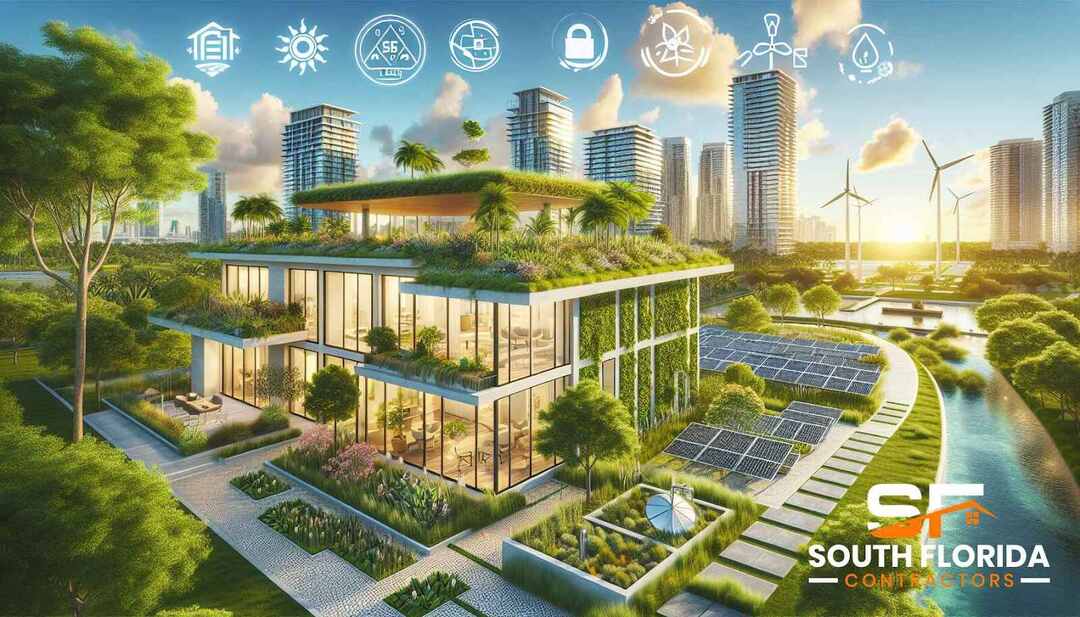
Renewable Energy Integration
The implementation of renewable energy systems is an essential step in establishing energy-efficient, eco-friendly buildings in South Florida. Renewable energy not only significantly decreases the dependency on fossil fuels but also aligns with the principles of sustainable construction that South Florida Contractors champion. By integrating renewable energy sources such as solar panels and wind turbines, buildings can achieve a higher degree of energy independence while contributing positively to the environment.
Incorporating solar panels for energy independence
Solar energy, abundant in South Florida, offers a promising pathway toward energy independence for both residential and commercial buildings. Incorporating solar panels is a strategic move to harness this plentiful resource, converting sunlight directly into electricity. This practice not only reduces utility bills but also lessens the building’s carbon footprint, making it an environmentally friendly option.
South Florida’s sunny climate is ideal for solar panel installation, allowing buildings to generate significant amounts of clean energy throughout the year. By prioritizing solar energy in construction, South Florida Contractors are at the forefront of the green building movement, providing sustainable solutions that meet the rising demand for renewable energy in construction. This initiative mirrors the broader goal of transitioning towards a more sustainable and energy-secure future, reinforcing South Florida’s commitment to green building practices.
Harnessing wind energy in suitable locations
Wind energy, though less commonly utilized than solar power in South Florida, presents an untapped opportunity for renewable energy generation in specific locations. By identifying and harnessing wind energy in areas with favorable wind conditions, South Florida Contractors can integrate wind turbines as part of a comprehensive renewable energy system.
Wind turbines, capable of converting kinetic energy from the wind into electricity, can significantly supplement a building’s energy supply, especially in coastal areas where wind conditions are optimal. This integration of wind energy contributes to a diversified energy portfolio for buildings, enhancing their sustainability while reducing reliance on traditional energy sources. South Florida’s exploration of wind energy underscores the region’s innovative approach to green building, pushing the boundaries of renewable energy integration in construction.
Connecting to the grid: Net metering in South Florida
Net metering is a critical component of renewable energy integration in South Florida, allowing buildings with solar panels or wind turbines to send excess energy back to the grid. This system balances energy consumption and production, providing credits to building owners for the surplus energy generated. As a result, net metering promotes the adoption of renewable energy sources by making them more economically viable and attractive to property owners.
South Florida Contractors actively advocate for and implement net metering systems in their renewable energy projects, ensuring that buildings are not just consuming energy, but also contributing to the overall energy supply. This collaborative approach to energy management enhances the efficiency of the electrical grid while encouraging wider adoption of renewable energy technologies. Net metering exemplifies how South Florida is leading the charge in green building practices, leveraging innovative policies and technologies to foster a more sustainable construction landscape.
By focusing on renewable energy integration through solar panels, wind energy, and net metering, South Florida Contractors are setting a precedent for sustainable and energy-efficient construction. This commitment to renewable energy not only aligns with environmental goals but also offers practical benefits for building owners, from reduced energy costs to increased property value. As South Florida continues to embrace renewable energy, it showcases the region’s dedication to building a greener, more sustainable future.
Conclusion: Building a Greener Future
As we navigate towards a more sustainable future, the construction industry in South Florida stands at the forefront of this transformative journey. The practices, materials, and technologies we embrace today will pave the way for a more energy-efficient, eco-friendly tomorrow. In this concluding section, we delve into the pivotal role of contractors in promoting energy efficiency, the emerging trends in sustainable construction, and how South Florida is epitomizing green building practices.
The pivotal role of contractors in promoting energy efficiency
Contractors play a crucial role in shaping the built environment. In South Florida, contractors are not just builders, they are visionaries who are steering the construction industry towards a greener future. By adopting energy-efficient construction practices, such as installing high-efficiency HVAC systems and incorporating solar energy applications, contractors are reducing the carbon footprint of new buildings. Furthermore, their dedication to utilizing eco-friendly insulation and sustainable landscaping materials underscores a commitment to not only meet the current needs of clients but also to consider the long-term impact on the planet.
The expertise and innovation of South Florida contractors in integrating smart home technology and energy-efficient lighting solutions exemplify their pivotal role in promoting sustainability. Their contributions are vital in transforming traditional buildings into modern, energy-efficient structures that set a standard for future developments.
Future trends in sustainable construction
The horizon of sustainable construction is continually evolving, with new trends emerging as technology advances and societal awareness grows. One significant trend is the increasing integration of renewable energy sources. Solar panels and wind energy solutions are becoming more prevalent, driven by both environmental considerations and the potential for long-term cost savings. Additionally, there’s a growing emphasis on building materials that are not only sustainable but also promote health and well-being, such as low-VOC paints and natural building materials.
Another promising trend is the rise of modular and prefabricated construction. These methods offer the potential for more efficient builds with less waste, aligning with the principles of sustainable construction. As technology progresses, we also anticipate an uptick in the use of artificial intelligence and machine learning to optimize building designs for energy efficiency and minimal environmental impact.
How South Florida is leading the way in green building practices
South Florida is setting a benchmark in green building practices. With its unique climate challenges and dedication to sustainability, the region demonstrates a comprehensive approach to eco-friendly construction. From achieving LEED certification for buildings to adopting innovative green roofing solutions, South Florida is at the helm of fostering green construction methodologies. Contractors in the region are not only adept at incorporating energy-efficient windows and doors and maximizing the use of renewable energy but are also pioneering in optimizing water use and quality, reflecting a holistic approach to green construction.
Moreover, South Florida’s commitment to adhering to and exceeding Florida building codes for energy efficiency, alongside pursuing Net Zero Energy Building standards, showcases the region’s leadership in sustainable construction. This commitment serves as an inspiration and a model for other regions to follow, underlining the potential of concerted efforts in building a greener future.
In conclusion, the journey towards sustainability in construction is a collaborative endeavor, involving contractors, builders, architects, and the wider community. South Florida Contractors, with their innovative approach and dedication to green building practices, are not just part of this transformation, they are leading it. As we look to the future, their role in shaping a sustainable, energy-efficient, and environmentally conscious landscape will undoubtedly be pivotal, marking South Florida as a leader in the global movement towards greener building practices.
